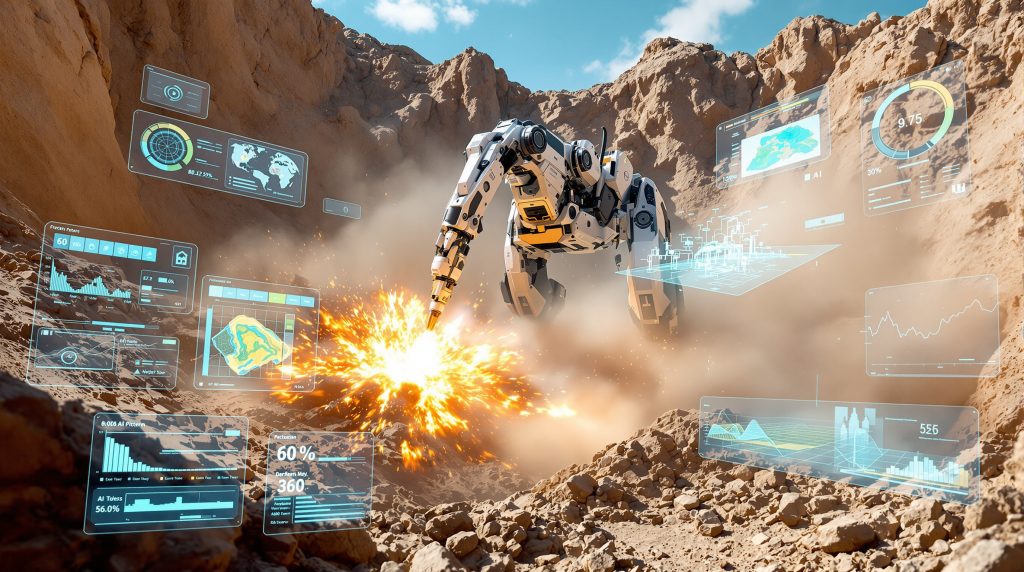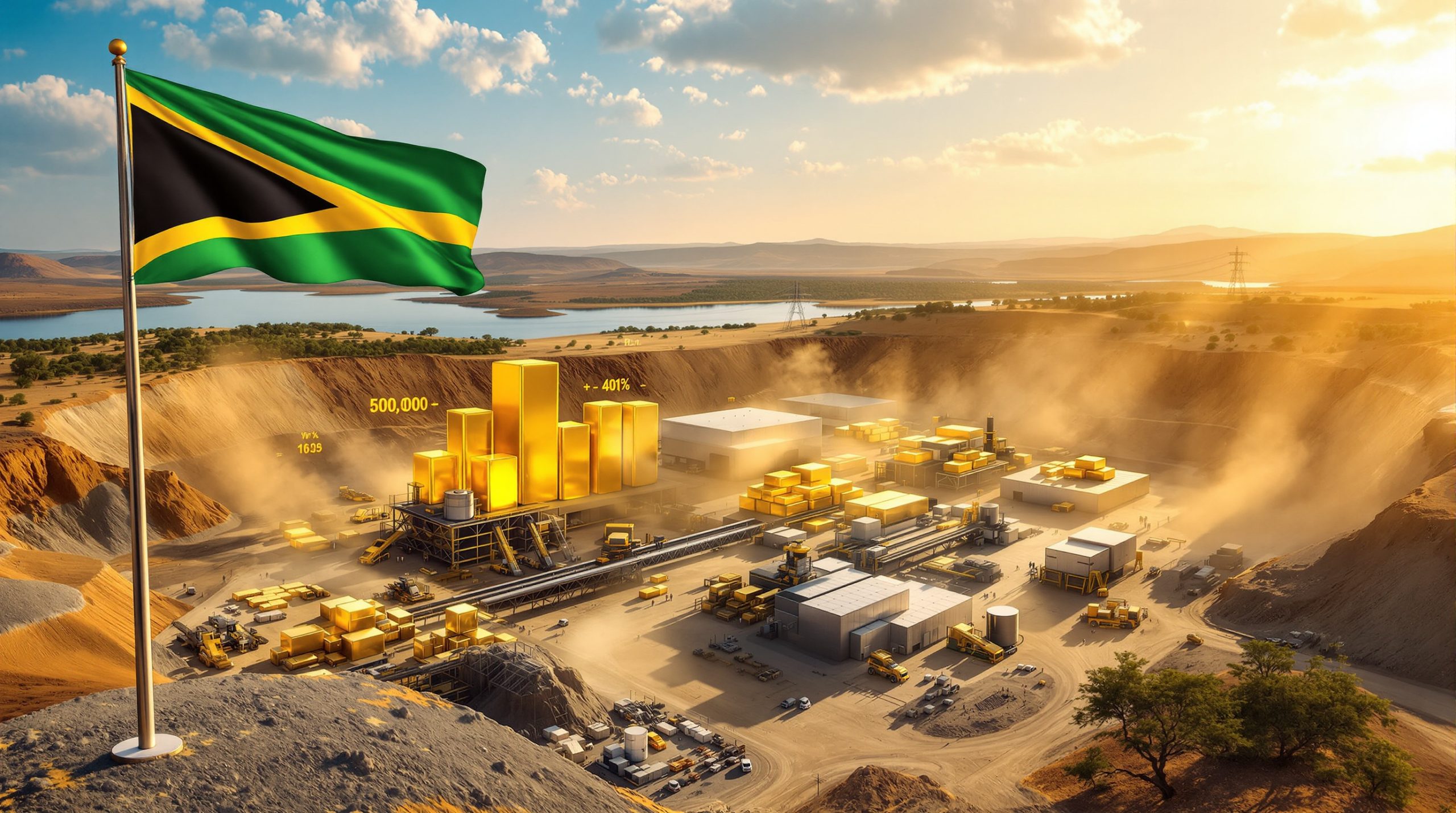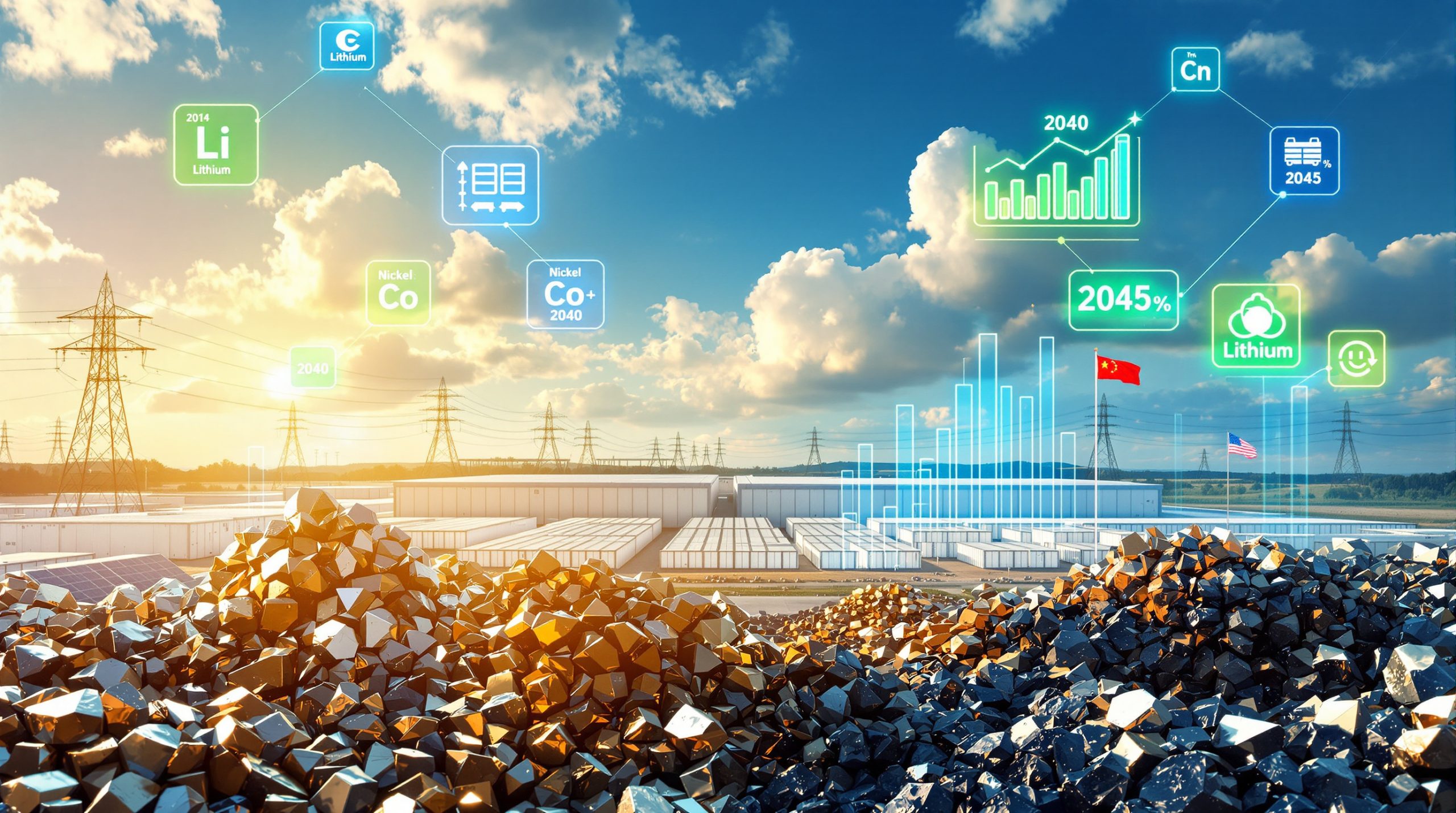Revolutionizing Mining Operations: The Evolution of Robotic Blasting Technology
Robotic blasting technology represents a significant leap forward in mining operations, combining automation, precision engineering, and digital control systems to transform traditional blasting processes. This revolutionary approach replaces conventional manual methods with sophisticated robotic systems that enhance safety, efficiency, and environmental performance across mining operations worldwide.
Key Components of Modern Robotic Blasting Systems
Modern robotic blasting systems incorporate several critical components that work together to deliver superior performance:
- Automated robotic arms with multi-axis articulation for precise explosive placement
- Advanced sensor arrays that create detailed terrain mapping in real-time
- AI-powered algorithms that optimize blast patterns based on geological conditions
- Remote operation capabilities allowing control from safe distances
- Ruggedized chassis designs engineered specifically for harsh mining environments
- Electric propulsion systems that significantly reduce emissions and environmental impact
The integration of these components creates a comprehensive system that outperforms traditional blasting methods across virtually every metric.
The Market Evolution of Mining Robotics
The global mining automation market was valued at approximately $3.5 billion in 2020 and is projected to reach $5.84 billion by 2026, growing at a CAGR of 8.9%, according to market research firm MarketsandMarkets. This growth reflects the increasing adoption of automated solutions throughout the mining value chain.
A notable development in this evolving landscape is Jevons Robotics' launch of the ARTEV1000 in September 2025, which complements their larger ARTEV6000 system. According to GeoDrilling International, Orica—a global leader in mining and civil blasting solutions—was among the first companies to adopt this "revolutionary step-change robotic blasting technology."
Industry experts project that continued investment in mining robotics will accelerate as mining companies seek to improve safety metrics, operational efficiency, and environmental performance in increasingly challenging extraction environments. Furthermore, the mining industry evolution is driving increased adoption of smart technologies across all operational aspects.
How Does Robotic Blasting Technology Work?
Core Operational Principles
Robotic blasting technology operates on several fundamental principles that distinguish it from conventional methods:
Precision Mapping Technology: These systems utilize high-definition 3D terrain scanning to create detailed topographical models of blast sites. This mapping capability enables unprecedented precision in charge placement.
Autonomous Navigation: Advanced robotic platforms can navigate challenging mining terrains independently, adjusting their path to accommodate obstacles and changing ground conditions.
Blast Pattern Optimization: Sophisticated AI algorithms analyze geological data to determine optimal charge placement, resulting in more efficient fragmentation and reduced explosives consumption.
Remote Command Systems: Operators control all functions from safe distances through secure communication links, eliminating the need for personnel to be present in hazardous blast zones.
Real-time Monitoring: Continuous feedback systems provide operators with vital information on blast performance and environmental conditions, allowing for immediate adjustments when necessary.
Technical Specifications of Leading Systems
The ARTEV (Autonomous Robotic Terrain Electric Vehicle) platform developed by Jevons Robotics represents the cutting edge of robotic blasting technology. According to GeoDrilling International, the company now offers both the ARTEV1000 and larger ARTEV6000 models, providing scalable solutions for different mining operations.
These robotic systems are specifically engineered for the extreme conditions found in mining environments, featuring weatherproof components, advanced obstacle detection, and redundant safety systems to ensure reliable operation even in challenging circumstances. Companies like Blastman Robotics have pioneered innovations that continue to advance the field.
What Are the Safety Benefits of Robotic Blasting Technology?
Removing Human Operators from Danger Zones
One of the most significant advantages of robotic blasting technology is the ability to remove human operators from hazardous blast zones. This fundamental shift in operational approach eliminates direct exposure to numerous safety hazards:
- Blast-zone injuries from flyrock, ground movement, and air blast
- Chronic exposure to harmful dust and particulate matter
- Noise-induced hearing damage from repeated blast exposures
- Musculoskeletal injuries associated with manual handling of blasting equipment
- Heat stress and other environmental hazards common in mining operations
By allowing personnel to operate from safe distances, robotic systems fundamentally transform the safety profile of blasting operations.
Enhanced Blast Precision and Control
Robotic blasting technology delivers superior precision and control compared to conventional methods:
- More accurate explosive placement reduces the risk of unplanned rock movement
- Computerized charge calculations minimize the potential for flyrock incidents
- Optimized blast timing sequences significantly decrease ground vibration
- Real-time monitoring systems detect and respond to anomalies before they become hazards
These precision advantages translate directly into safer operations, with fewer incidents and near-misses compared to traditional blasting approaches.
Safety Implications for Mining Operations
The adoption of robotic blasting technology has profound implications for overall mine safety:
- Reduced evacuation zone requirements due to more predictable blast outcomes
- Decreased incident rates related to blasting operations
- Lower exposure of personnel to hazardous conditions
- Enhanced compliance with increasingly stringent safety regulations
- More consistent safety performance across different operations and conditions
As more mining operations adopt these technologies, industry-wide safety metrics are expected to improve significantly, reducing both the human and financial costs associated with blasting-related incidents.
How Does Robotic Blasting Improve Operational Efficiency?
Production and Performance Metrics
Robotic blasting technology delivers measurable improvements in key production and performance metrics:
- Increased drilling and blasting productivity through optimized blast patterns
- Reduced cycle times between blasts due to faster setup and execution
- Improved fragmentation consistency leading to higher crusher throughput
- Decreased dilution rates resulting in higher-grade ore recovery
- Enhanced operational predictability and planning capability
These efficiency gains compound throughout the mining value chain, improving performance from extraction through processing. The implementation of AI in drilling and blasting has further accelerated these productivity improvements.
Cost Reduction Benefits
The adoption of robotic blasting technology yields significant cost benefits across multiple operational areas:
- Labor cost reductions through automated blast planning and execution
- Explosives consumption optimization through precision placement
- Lower maintenance costs due to optimized equipment utilization
- Decreased energy consumption across the blasting process
- Reduced downstream processing costs through improved fragmentation
These cost advantages provide a compelling economic case for technology adoption, with potential payback periods typically measured in months rather than years for operations with regular blasting requirements.
Operational Flexibility Advantages
Robotic blasting systems offer unprecedented operational flexibility:
- 24/7 operational capability regardless of weather or lighting conditions
- Rapid deployment and relocation between blast zones
- Adaptability to changing geological conditions through real-time programming
- Seamless integration with mine planning and production scheduling systems
- Scalable solutions that can be matched to operational requirements
This flexibility allows mining operations to optimize their blasting schedule and approach based on business needs rather than operational constraints, creating additional value beyond direct efficiency improvements.
What Are the Latest Innovations in Robotic Blasting Technology?
Autonomous Terrain Electric Vehicles (ARTEVs)
The development of purpose-built Autonomous Robotic Terrain Electric Vehicles (ARTEVs) represents a significant innovation in robotic blasting. Jevons Robotics' ARTEV1000 and ARTEV6000 platforms exemplify this approach, providing:
- All-electric propulsion systems with extended operational ranges
- Enhanced obstacle navigation capabilities for complex terrain
- Self-recovery features that reduce operational interruptions
- Modular design allowing for rapid attachment changes and maintenance
- Purpose-built chassis optimized for mining environments
These specialized platforms offer superior performance compared to adapted industrial robots, with capabilities specifically designed for the unique challenges of mining operations.
AI and Machine Learning Integration
The integration of artificial intelligence and machine learning capabilities is transforming robotic blasting technology:
- Self-learning algorithms that continuously optimize blast patterns based on previous results
- Predictive maintenance systems that identify potential failures before they occur
- Automatic geological classification from drilling data
- Real-time fragmentation analysis and adjustment
- Autonomous decision-making capabilities within pre-defined parameters
These AI-powered capabilities allow robotic systems to adapt and improve over time, delivering increasingly better results as they accumulate operational experience.
Digital Twin Technology
Digital twin technology is increasingly being applied to robotic blasting operations, creating virtual replicas of blast sites that allow for:
- Pre-blast modeling to predict outcomes with high accuracy
- Simulation of different blast approaches to determine optimal strategies
- Post-blast analysis comparing actual results to predicted outcomes
- Continuous improvement cycles through data-driven refinement
- Training and procedural optimization without disrupting actual operations
This virtual environment approach accelerates the optimization process while reducing the risks associated with testing new methodologies in live operations. Many operations now incorporate data‑driven mining operations strategies to maximize performance.
How Are Leading Mining Companies Implementing Robotic Blasting?
Implementation Strategies and Approaches
Mining companies are adopting various approaches to implementing robotic blasting technology:
- Phased deployment starting with non-critical operations to build experience
- Comprehensive staff training and development programs to build internal expertise
- Integration with existing mine management systems to maximize operational synergies
- Collaborative development with technology providers to address site-specific challenges
- Center of excellence models that develop and disseminate best practices across operations
These strategic approaches help organizations manage the transition to automated blasting while minimizing disruption to ongoing operations.
Case Study: Major Mining Corporation Adoption
According to GeoDrilling International, Orica has been among the first major companies to adopt robotic blasting technology. As a global leader in mining and civil blasting solutions, Orica's adoption signals growing industry confidence in the technology's capabilities and benefits.
The implementation of robotic blasting technology in major mining operations typically follows a careful, staged approach:
- Initial testing phase with limited units in controlled environments
- Expansion to broader implementation after successful trials
- Development of in-house expertise through specialized training programs
- Custom modifications to address site-specific challenges
- Integration with broader mine automation initiatives
This measured approach allows mining companies to realize benefits quickly while managing implementation risks effectively.
ROI and Performance Metrics
The return on investment for robotic blasting technology is driven by multiple factors:
- Reduced total blasting costs per ton of material moved
- Improved downstream processing efficiency
- Enhanced regulatory compliance reducing permitting delays
- Lower incident rates and associated costs
- Increased operational predictability and planning efficiency
While specific ROI figures vary based on operation size, blast frequency, and existing efficiency levels, many mining operations report significant financial benefits from implementing robotic blasting technology.
What Environmental Benefits Does Robotic Blasting Technology Offer?
Reduced Environmental Footprint
Robotic blasting technology delivers substantial environmental benefits:
- Decreased dust generation through precision blasting techniques
- Lower vibration impacts on surrounding ecosystems
- Minimized noise pollution through optimized timing and charge distribution
- Reduced carbon emissions from electric propulsion systems
- Smaller physical footprint compared to conventional blasting equipment
These environmental advantages help mining operations meet increasingly stringent regulatory requirements while improving relationships with local communities and other stakeholders.
Improved Resource Recovery
The precision of robotic blasting technology enhances resource recovery in several ways:
- Enhanced selectivity reducing waste rock production
- Better fragmentation leading to lower energy consumption in crushing and grinding
- Decreased water usage in downstream processing due to optimized particle size
- Extended mine life through more efficient resource extraction
- Reduced ore loss and dilution during the blasting process
These resource recovery benefits contribute to more sustainable mining practices while simultaneously improving economic outcomes. Additionally, mining decarbonisation benefits are realized through reduced fuel consumption and optimized operations.
Regulatory Compliance Advantages
Robotic blasting technology offers significant advantages for regulatory compliance:
- Automated documentation of environmental performance metrics
- Real-time monitoring of dust, vibration, and noise levels
- Consistent adherence to permitted blast parameters
- Detailed data collection supporting environmental reporting requirements
- Proactive management of environmental impacts
These compliance advantages reduce regulatory risks while potentially accelerating permitting processes for new or expanded operations.
What Challenges Exist in Adopting Robotic Blasting Technology?
Implementation Barriers
Despite its benefits, robotic blasting technology faces several implementation challenges:
- Significant capital investment requirements for equipment acquisition
- Integration complexities with existing mine planning systems
- Technical expertise requirements for operation and maintenance
- Regulatory approval processes for autonomous equipment
- Organizational change management considerations
Mining companies must address these barriers through careful planning and phased implementation approaches to realize the technology's full potential.
Technical Limitations
Current robotic blasting technology has certain technical limitations:
- Performance constraints in extreme weather conditions
- Communication reliability challenges in deep pit operations
- Battery life limitations in remote locations
- Sensor accuracy issues in high-dust environments
- Cybersecurity considerations for remotely operated systems
Ongoing research and development efforts are addressing these limitations, with significant improvements expected in future generations of the technology.
Change Management Considerations
The human and organizational aspects of technology adoption present important challenges:
- Workforce concerns about job displacement
- Cultural resistance to new technologies
- Training requirements for existing personnel
- Modifications to established operational procedures
- Leadership alignment and support for technology adoption
Successful implementation requires addressing these change management considerations alongside the technical aspects of deployment.
How Will Robotic Blasting Technology Evolve in the Future?
Emerging Technology Trends
Several emerging trends will shape the future evolution of robotic blasting technology:
- Swarm robotics enabling multiple units to work collaboratively
- Advanced power systems for extended operational range
- New materials science applications improving durability and performance
- Enhanced computational capabilities for more sophisticated blast optimization
- Deeper integration with other autonomous mining systems
These technological trends will drive continued innovation in the field, further expanding capabilities and applications.
Industry Forecasts and Predictions
Industry experts anticipate several developments in robotic blasting technology adoption:
- Accelerating implementation across major mining operations globally
- Integration with autonomous drilling and loading equipment
- Development of specialized units for underground applications
- Standardization of robotic blasting protocols across the industry
- Emergence of technology-as-a-service business models
These developments will reshape mining operations, potentially transforming industry standards and expectations for blasting performance. Modern mine planning increasingly incorporates these technologies from the earliest design stages.
Research and Development Focus Areas
Current R&D efforts in robotic blasting technology focus on several key areas:
- Enhanced sensor fusion for improved environmental awareness
- Next-generation energy storage solutions
- Advanced materials for increased durability in harsh conditions
- Artificial intelligence applications for adaptive blast design
- Improved human-machine interfaces for intuitive operation
Progress in these areas will address current limitations while opening new possibilities for technology application and performance.
FAQ: Robotic Blasting Technology
What is the typical return on investment for robotic blasting technology?
The ROI for robotic blasting technology varies based on operation size, blast frequency, and existing efficiency levels. Key value drivers include reduced labor costs, improved fragmentation, lower explosives consumption, and enhanced downstream processing efficiency. Most operations implementing this technology report positive returns within the first year of operation.
How does robotic blasting technology integrate with existing mine planning systems?
Modern robotic systems feature open API architectures that allow seamless integration with common mine planning software. Data flows bidirectionally, with blast designs transferring to the robotic system and actual performance data feeding back into planning software for continuous optimization. This integration capability is essential for maximizing the value of the technology within broader mining operations.
What training is required for personnel to operate robotic blasting equipment?
Operating personnel typically require specialized training that combines theoretical knowledge with practical experience. This training covers system operation, maintenance, troubleshooting, and safety procedures. Many manufacturers offer comprehensive training programs and certification for operators and maintenance personnel, ensuring competent system management.
How do robotic blasting systems perform in adverse weather conditions?
Advanced robotic blasting systems are designed with weatherproofing features that allow operation in challenging conditions, including rain, dust, and extreme temperatures. While performance may be somewhat affected in severe weather, these systems generally maintain operational capability in conditions that would halt conventional blasting operations.
What safety redundancies are built into robotic blasting technology?
Modern systems incorporate multiple safety layers, including emergency shutdown systems, geofenced operational boundaries, obstacle detection and avoidance, communication loss protocols, and manual override capabilities. Many units also feature self-diagnostic systems that prevent operation if critical components are compromised, ensuring safe operation even in challenging circumstances.
Looking Forward: The Future of Mining Automation
The evolution of robotic blasting technology represents just one aspect of a broader transformation occurring throughout the mining industry. As automation continues to advance across drilling, loading, hauling, and processing operations, we can expect increasingly integrated approaches that optimize the entire mining value chain.
For mining professionals seeking to stay ahead of these technological developments, ongoing education and training will be essential. The skills required to manage and optimize automated mining operations differ significantly from those needed in conventional mining, creating both challenges and opportunities for industry participants.
As robotic blasting technology continues to mature and evolve, it will play an increasingly important role in shaping the future of mining operations worldwide, delivering improvements in safety, efficiency, and environmental performance that were previously unattainable with conventional approaches.
Looking for Cutting-Edge Mining Investment Opportunities?
Discover the next major ASX mining breakthrough with Discovery Alert's proprietary Discovery IQ model, which provides real-time notifications of significant mineral discoveries before the broader market reacts. Visit our discoveries page to understand how revolutionary technologies like robotic blasting can create substantial investment returns when identified early.




